Ducks with orange beaks have always been a fascinating sight for bird enthusiasts. Their vibrant and striking appearance immediately catches the eye and leaves a lasting impression.
But have you ever wondered what purpose this distinctive feature serves? It turns out that the color of a duck’s beak can reveal a lot about its diet, food habits, habitat, and even its health. In this post, we’ll explore the fascinating world of ducks with orange beaks and uncover the secrets behind this striking feature.
American Pekin Duck
American Pekin Duck
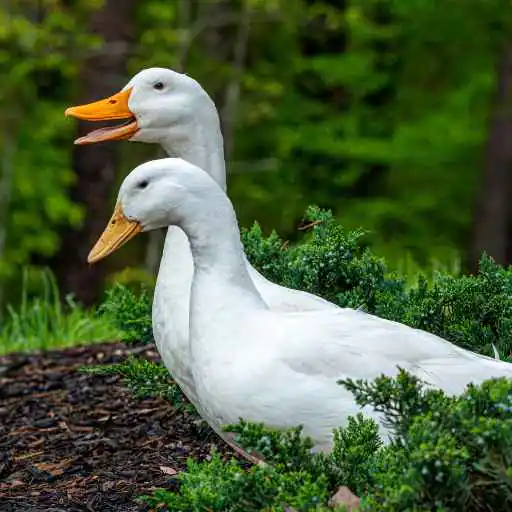
The American Pekin duck is a popular domesticated breed of duck.
- The American Pekin is a breed of duck from China raised for meat.
- It is big, grows quickly, and can lay lots of eggs.
- It is sometimes kept for fancy and showing.
They are known for their round bodies, short necks, and bright orange beaks. These ducks can weigh between 6 and 8 pounds and come in colors like white, black, blue, and chocolate.
American Pekins are white ducks that eat both plants and animals. They like to eat duck feed, grains, fruits, and vegetables. They also need access to clean water to drink and bathe in.
American Pekins are originally from North America and are kept as pets or on a farm. They need a safe place to sleep at night and a big, fenced area to play in during the day. They also need shade and a dry area for nesting.
Black Scoter
Black Scoter

The black scoter, also known as the American scoter (Melanitta americana), is a sea duck exhibiting sexual dimorphism, meaning that males and females have distinct physical differences.
- Black scoters are found in North America’s coastal areas.
- Males and females have different plumage.
- They feed on aquatic invertebrates and dive underwater to look for food.
Male black scoters have predominantly black plumage with a yellow knob on their bill, which becomes more prominent during the nesting season. On the other hand, females have dark brown feathers with lighter underparts and a pale patch on their cheeks. Both males and females have a thick, heavy bill adapted for their feeding habits.
Black scoters prefer to inhabit coastal marine environments, such as rocky shores, bays, and estuaries. They can be found in Alaska, the Canadian Maritimes, and the northeastern United States.
During the mating season, black scoters are commonly found in freshwater habitats, including lakes and ponds, in the boreal forests of Canada and Alaska.
Black scoters are omnivores and feed on various marine invertebrates, including mollusks, crustaceans, and aquatic insects. They will also consume small fish and plant matter. These ducks dive underwater to forage for their food, using their strong, webbed feet to prop themselves through the water.
Black-bellied Whistling Duck
Black-bellied Whistling Duck

The black-bellied whistling duck (Dendrocygna autumnalis) is a common bird in Central and South America. It was previously known as the black-bellied tree duck.
- One of two whistling duck species native to North America.
- They prefer warm climates such as those in the Gulf Coast, southeast Texas, Central America and northern Argentina.
- Females have long necks and are cavity nesters.
The black-bellied whistling duck is a medium-sized bird with a light brown head, a chestnut cap and lower neck, long pink legs, a gray face and upper neck, a white eye ring, a dark brown body, and a black belly. Both the male and female look similar with broad wings, with the males being slightly larger. It grows to an average length of 18 to 19 inches.
Black-bellied whistling ducks prefer wetland habitats and have a large population range in the Americas including parts of South America, breeding in southern Texas, Louisiana, South Carolina, Florida and coastal Mexico.
It is pretty common for female whistling ducks to use abandoned buildings, tree cavities and nest boxes to lay eggs in. Ducklings or young ducks leap from nest cavities of trees 24 to 48 hours from hatching.
Black-bellied whistling ducks are omnivorous, eating plant material, seeds, submerged vegetation, insects, and small animals, and are primarily nocturnal feeders.
Common Merganser
Common Merganser
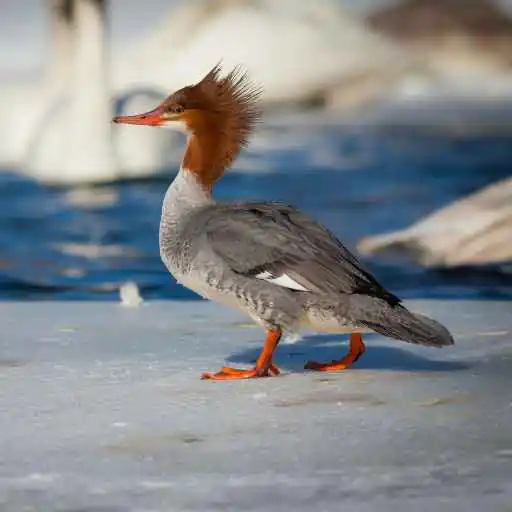
The common merganser is a large sea duck found in Europe, Asia, and North America. It is a member of the Anatidae family which also includes geese and swans.
- Males have a white body, black head, and grey rump and tail.
- It eats fish and other aquatic animals.
- It lives in coastal habitats and brackish wetland environment.
It feeds mainly on fish but also eats other aquatic prey.
During the nesting season, males have a white body with a salmon-pink tinge, a black head with an iridescent green gloss, and a grey rump and tail. Females and non-breeding males are largely grey. Juveniles have a short black-edged white stripe between the eye and the bill.
Common mergansers have serrated bills to help them grip their prey. They have often seen swimming or resting on rocks in midstream or on the edge of floating ice. They are wary birds with a low, harsh croak as their familiar vocalization.
Common mergansers migrate south in the cold months, except for those on the Pacific coast who are permanent residents. Some male populations also undergo molt migration.
Falkland Steamer Duck
Falkland Steamer Duck

The Falkland steamer duck is a flightless duck found in the South Atlantic Ocean on the Falkland Islands.
- It is different from the flying steamer duck because it cannot fly.
- These ducks live near the shore and in freshwater ponds and mainly eat mollusks and crustaceans.
- They form small family groups and sometimes gather in larger groups.
The Falkland steamer duck is a flightless duck found in the Falkland Islands. They have orange bills and yellow-orange feet, and males have brownish-grey plumage with a light grey-white head, while females are darker with a brown neck and olive green beak.
Falkland steamer ducks feed mainly on marine mollusks and crustaceans, diving to find their prey on the sea floor. They live in family groups of other birds on rugged shores and sheltered bays and venture inland to freshwater ponds up to 400m from the coast.
The species is limited to the Falkland Islands in the South Atlantic Ocean and is a year-round resident. The flying steamer duck is similar in appearance but can fly, while the Falkland steamer duck is strictly flightless.
King Eider
King Eider
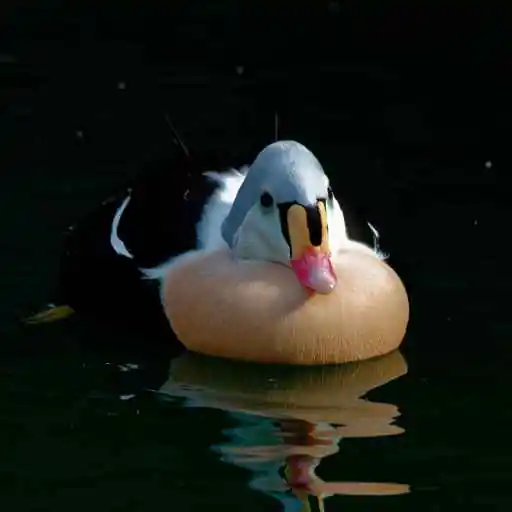
The King Eider is a large sea duck that breeds in the Northern Hemisphere Arctic.
- Large sea ducks that lay 4-7 eggs in a nest lined with grass and down.
- Males are black with buff-tinged white breasts, females are warm brown with blackish chevrons.
- They migrate to tundra habitats in June and July.
The king eider is a large sea duck found throughout the Arctic. They breed along Arctic coasts and migrate to tundra habitats to breed.
The males are larger and more colorful than the females. Males have a black body with white feathers at the base, white breasts, and a multicolored head with a red bill and a distinctive yellow knob. Females are warm brown with black chevrons on their feathers.
King eiders eat benthic invertebrates and small invertebrates from freshwater lakes and ponds.
During winter, they form large flocks and can be found in arctic and subarctic marine areas. The population is widely distributed and can be found in Alaska, Canada, Greenland, Svalbard, Russia, and other regions.
Mallard
Mallard

The mallard is a common and widespread dabbling duck found in North America, Europe, Asia, and parts of Africa.
- A sexually dimorphic duck species
- Found in a wide range of aquatic habitats across the Northern Hemisphere
- Opportunistic feeders and highly adaptable
Males have green heads, yellow bills, and blue-purple wings, while females have brown-mottled plumage.
Mallards prefer aquatic habitats and are opportunistic feeders who consume aquatic plants, insects, and grains from recently harvested fields. They also inhabit wetlands and grassy areas of city parks.
Mallards are most abundant and widely distributed in North America, where they breed in the north and migrate south to overwinter in warmer regions.
Mexican Duck
Mexican Duck

The Mexican duck (Anas diazi) is a dabbling duck native to the southwestern United States and Mexico.
- The American Black Duck looks similar to a female mallard.
- They live in wetlands and eat plants.
- Their numbers have gone down, so the US Fish & Wildlife Service is trying to help.
While the species is resident in most wetlands, it migrates south to Mexico during cold months. The Mexican duck is known for its fondness of green shoots of alfalfa and grazing on irrigated fields at night.
At a glance, the Mexican duck appears similar to a female mallard, with a slightly darker body. The duck is predominantly brown, with a blue speculum edged with white, which is more obvious when the duck is in flight or at rest. The male Mexican duck can be distinguished from the female by its brighter yellow bill.
Mexican ducks inhabit wetlands and marshes, foraging for plant food by dabbling or grazing. During the breeding season, they build their nests near water and lay an average of eight eggs. The female is responsible for incubating the eggs for around a month until they hatch.
Spectacled Eider
Spectacled Eider
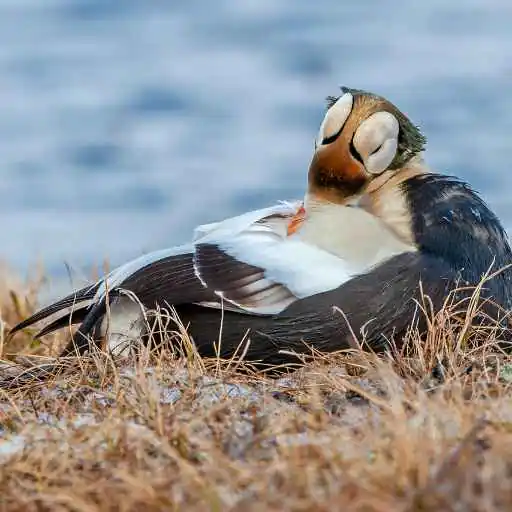
The Spectacled Eider is a sea duck closely related to the Common Eider and King Eider, and the Steller’s Eider acts as a link between eiders and other sea ducks.
- A shorebird known for its unique facial pattern and a bright orange bill.
- It builds a bowl-shaped nest near water bodies, such as shorelines, peninsulas and small islands.
- It eats mollusks, aquatic insects, crustaceans and plants such as sedges, grasses and berries.
These birds have a distinctive appearance, with the male having a unique facial pattern that gives it a ghostly aura. During the mating season, the male has white on its chin, throat, neck, and back, while its breast, rump, tail, and belly are blackish. The bird’s eyes are surrounded by a white “spectacle,” giving the bird its name.
The female is dull brown with black streaks on its paler brown head and neck.
Spectacle eiders are uncommon and poorly known, and they usually occur in small flocks in remote habitats that are often far from humans. The spectacled eider breeds along the coasts of northern Siberia, from east of the Lena Delta to northwestern Alaska. These ducks spend winters in the Bering Sea among sea ice.
Spectacle eiders feed mainly on mollusks such as clams and gastropods during breeding and at sea, and they forage by dabbling in shallow water on the tundra or by diving and swimming underwater at sea.
The population of the Spectacled Eider is declining due to predation and habitat loss, and it is currently considered a threatened species.
Surf Scoter
Surf Scoter
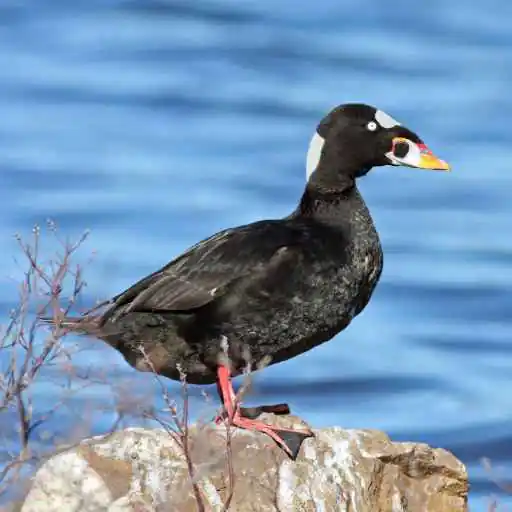
The surf scoter is a large sea duck found in North America with a mostly black or brown plumage.
- It is the smallest scoter species based on average weight.
- It eats mussels, herring spawn, and other small invertebrates.
- During molt period, it migrates to wetland areas to find food with lower predation risks.
The surf scoter is a sea duck found in North America.
Adult males are black with white patches on the forehead and nape, while females are smaller and browner. They have a unique bill pattern and become flightless during molting.
Surf scoters breed in Northern Canada and Alaska, wintering along North America’s Pacific and Atlantic coasts. Surf scoters feed on benthic invertebrates, including mussels.
Surf scoters are highly gregarious and forage in small groups of other ducks on freshwater invertebrates during the nesting season and on marine organisms in flocks during the rest of the year. They adjust their foraging effort and habitat selection according to prey availability.
Velvet Scoter
Velvet Scoter

The velvet scoter is a large sea duck breeding in Northern Europe and Asia west of the Yenisei Basin.
- The velvet scoter lives near lakes and pools in cold places and migrates to the coasts of western Europe in winter.
- Its diet includes mollusks, crustaceans, insect larvae, worms, and small fish.
- It uses its wings and webbed feet to swim underwater and search for food, even at night.
The velvet scoter is a large sea duck found in northern Europe and Asia. It is bigger than the common scoter and can be seen in mixed flocks. The male has glossy blackish plumage with a white wingbar and a white eye patch below the eye. The female is dark brown with a whitish patch on the head.
During the non-breeding season, the velvet scoter lives in shallow water along the coast in temperate regions.
Breeding populations are dispersed across Eurasia, including Scandinavia, Estonia, Turkey, Armenia, and Georgia. It breeds near lakes and large pools in boreal forests and the Arctic tundra.
The velvet scoter feeds primarily on saltwater mollusks and crustaceans, diving with partially open wings.
White-winged Scoter
White-winged Scoter
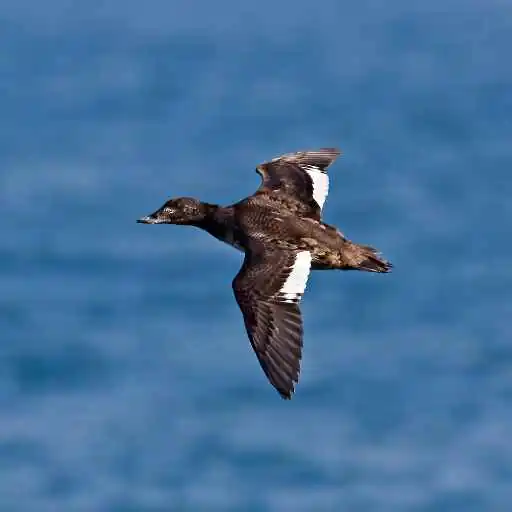
The White-winged Scoter is a large sea duck with a sloping bill and white patches in the wing native to North America.
- A large sea duck with black plumage, white spots around the eyes and white patches in its wings.
- It eats mussels and crustaceans, and it can be seen in flocks near the ocean, lakes, and rivers.
- In the breeding season, it nests near gull colonies in dense vegetation.
Adult males are mostly dark with a bulge at the base of their orange-red bill, while females are largely brownish with a large, sloping, dark bill and two white facial patches.
In winter, white-winged scoters eat mussels and crustaceans and hold their breath for over a minute underwater to catch their prey.
These ducks breed in the boreal forest near large lakes and ponds surrounded by shrubs. They build their nest on the ground, usually near the water. They remain inland, especially on the Great Lakes, and move to coastal areas during winter.
White-winged scoters are the scarcest of the three scoter species in North America and can be spotted in large mixed flocks of sea ducks along rocky shorelines and sandbars.
Key Takeaways
- Ducks with orange bills include species of dabbling and diving ducks.
- American Pekin ducks are domestic ducks with round bodies, short necks, and bright orange beaks.
- Black scoters are black with yellow knobs on their bills during breeding season and eat aquatic invertebrates.
- Black-bellied whistling ducks live in wetlands in the Americas.
- Male black-bellied whistling ducks have light brown heads and necks while females have olive green bills.
- Common mergansers have serrated bills and eat prey along the coasts of North America during winter.

